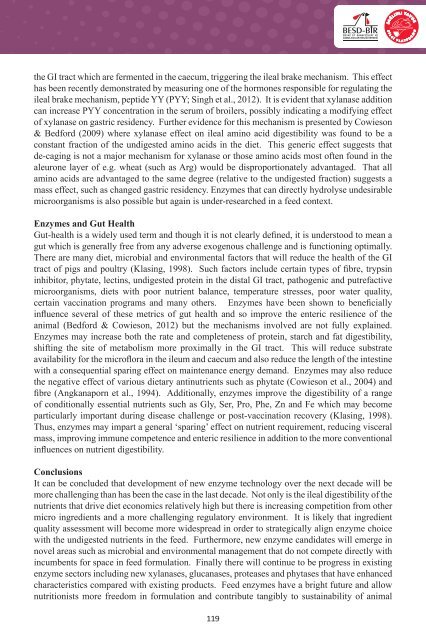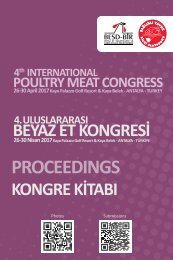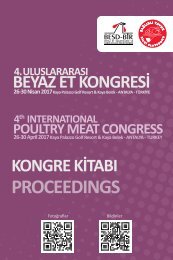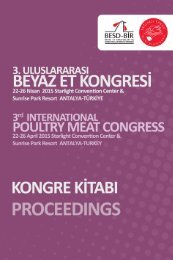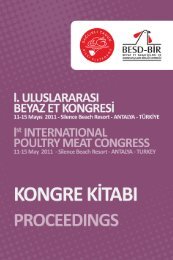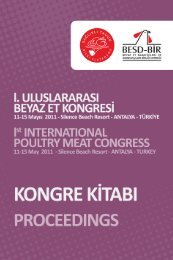3rd International Poultry Meat Congress
Proceedings
Proceedings
You also want an ePaper? Increase the reach of your titles
YUMPU automatically turns print PDFs into web optimized ePapers that Google loves.
the GI tract which are fermented in the caecum, triggering the ileal brake mechanism. This effect<br />
has been recently demonstrated by measuring one of the hormones responsible for regulating the<br />
ileal brake mechanism, peptide YY (PYY; Singh et al., 2012). It is evident that xylanase addition<br />
can increase PYY concentration in the serum of broilers, possibly indicating a modifying effect<br />
of xylanase on gastric residency. Further evidence for this mechanism is presented by Cowieson<br />
& Bedford (2009) where xylanase effect on ileal amino acid digestibility was found to be a<br />
constant fraction of the undigested amino acids in the diet. This generic effect suggests that<br />
de-caging is not a major mechanism for xylanase or those amino acids most often found in the<br />
aleurone layer of e.g. wheat (such as Arg) would be disproportionately advantaged. That all<br />
amino acids are advantaged to the same degree (relative to the undigested fraction) suggests a<br />
mass effect, such as changed gastric residency. Enzymes that can directly hydrolyse undesirable<br />
microorganisms is also possible but again is under-researched in a feed context.<br />
Enzymes and Gut Health<br />
Gut-health is a widely used term and though it is not clearly defined, it is understood to mean a<br />
gut which is generally free from any adverse exogenous challenge and is functioning optimally.<br />
There are many diet, microbial and environmental factors that will reduce the health of the GI<br />
tract of pigs and poultry (Klasing, 1998). Such factors include certain types of fibre, trypsin<br />
inhibitor, phytate, lectins, undigested protein in the distal GI tract, pathogenic and putrefactive<br />
microorganisms, diets with poor nutrient balance, temperature stresses, poor water quality,<br />
certain vaccination programs and many others. Enzymes have been shown to beneficially<br />
influence several of these metrics of gut health and so improve the enteric resilience of the<br />
animal (Bedford & Cowieson, 2012) but the mechanisms involved are not fully explained.<br />
Enzymes may increase both the rate and completeness of protein, starch and fat digestibility,<br />
shifting the site of metabolism more proximally in the GI tract. This will reduce substrate<br />
availability for the microflora in the ileum and caecum and also reduce the length of the intestine<br />
with a consequential sparing effect on maintenance energy demand. Enzymes may also reduce<br />
the negative effect of various dietary antinutrients such as phytate (Cowieson et al., 2004) and<br />
fibre (Angkanaporn et al., 1994). Additionally, enzymes improve the digestibility of a range<br />
of conditionally essential nutrients such as Gly, Ser, Pro, Phe, Zn and Fe which may become<br />
particularly important during disease challenge or post-vaccination recovery (Klasing, 1998).<br />
Thus, enzymes may impart a general ‘sparing’ effect on nutrient requirement, reducing visceral<br />
mass, improving immune competence and enteric resilience in addition to the more conventional<br />
influences on nutrient digestibility.<br />
Conclusions<br />
It can be concluded that development of new enzyme technology over the next decade will be<br />
more challenging than has been the case in the last decade. Not only is the ileal digestibility of the<br />
nutrients that drive diet economics relatively high but there is increasing competition from other<br />
micro ingredients and a more challenging regulatory environment. It is likely that ingredient<br />
quality assessment will become more widespread in order to strategically align enzyme choice<br />
with the undigested nutrients in the feed. Furthermore, new enzyme candidates will emerge in<br />
novel areas such as microbial and environmental management that do not compete directly with<br />
incumbents for space in feed formulation. Finally there will continue to be progress in existing<br />
enzyme sectors including new xylanases, glucanases, proteases and phytases that have enhanced<br />
characteristics compared with existing products. Feed enzymes have a bright future and allow<br />
nutritionists more freedom in formulation and contribute tangibly to sustainability of animal<br />
119


